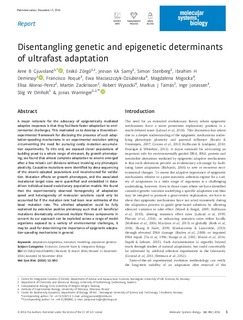| dc.contributor.author | Gjuvsland, Arne Bjørke | |
| dc.contributor.author | Zörgö, Enikö Beatrix | |
| dc.contributor.author | Antony Samy, Jeevan Karloss | |
| dc.contributor.author | Stenberg, Simon | |
| dc.contributor.author | Demirsoy, Ibrahim H | |
| dc.contributor.author | Roque, Francisco | |
| dc.contributor.author | Maciaszczyk-Dziubinska, Ewa | |
| dc.contributor.author | Migocka, Magdalena | |
| dc.contributor.author | Alonso-Perez, Elisa | |
| dc.contributor.author | Zackrisson, Martin | |
| dc.contributor.author | Wysocki, Robert | |
| dc.contributor.author | Tamas, Markus J | |
| dc.contributor.author | Jonassen, Inge | |
| dc.contributor.author | Omholt, Stig William | |
| dc.contributor.author | Warringer, Jonas | |
| dc.date.accessioned | 2018-01-02T15:51:22Z | |
| dc.date.available | 2018-01-02T15:51:22Z | |
| dc.date.created | 2017-01-27T14:36:38Z | |
| dc.date.issued | 2016 | |
| dc.identifier.issn | 1744-4292 | |
| dc.identifier.uri | http://hdl.handle.net/11250/2474167 | |
| dc.description.abstract | A major rationale for the advocacy of epigenetically mediated adaptive responses is that they facilitate faster adaptation to environmental challenges. This motivated us to develop a theoretical–experimental framework for disclosing the presence of such adaptation‐speeding mechanisms in an experimental evolution setting circumventing the need for pursuing costly mutation–accumulation experiments. To this end, we exposed clonal populations of budding yeast to a whole range of stressors. By growth phenotyping, we found that almost complete adaptation to arsenic emerged after a few mitotic cell divisions without involving any phenotypic plasticity. Causative mutations were identified by deep sequencing of the arsenic‐adapted populations and reconstructed for validation. Mutation effects on growth phenotypes, and the associated mutational target sizes were quantified and embedded in data‐driven individual‐based evolutionary population models. We found that the experimentally observed homogeneity of adaptation speed and heterogeneity of molecular solutions could only be accounted for if the mutation rate had been near estimates of the basal mutation rate. The ultrafast adaptation could be fully explained by extensive positive pleiotropy such that all beneficial mutations dramatically enhanced multiple fitness components in concert. As our approach can be exploited across a range of model organisms exposed to a variety of environmental challenges, it may be used for determining the importance of epigenetic adaptation‐speeding mechanisms in general. | nb_NO |
| dc.language.iso | eng | nb_NO |
| dc.publisher | Wiley Open Access | nb_NO |
| dc.rights | Navngivelse 4.0 Internasjonal | * |
| dc.rights.uri | http://creativecommons.org/licenses/by/4.0/deed.no | * |
| dc.title | Disentangling genetic and epigenetic determinants of ultrafast adaptation | nb_NO |
| dc.type | Journal article | nb_NO |
| dc.type | Peer reviewed | nb_NO |
| dc.description.version | publishedVersion | nb_NO |
| dc.source.volume | 12 | nb_NO |
| dc.source.journal | Molecular Systems Biology | nb_NO |
| dc.source.issue | 12 | nb_NO |
| dc.identifier.doi | 10.15252/msb.20166951 | |
| dc.identifier.cristin | 1439471 | |
| dc.relation.project | Norges forskningsråd: 222364 | nb_NO |
| dc.relation.project | Notur/NorStore: NN4653K | nb_NO |
| dc.relation.project | Norges forskningsråd: 223257 | nb_NO |
| dc.description.localcode | © 2016 The Authors. Published under the terms of the CC BY 4.0 license. | nb_NO |
| cristin.unitcode | 194,66,10,0 | |
| cristin.unitname | Institutt for biologi | |
| cristin.ispublished | true | |
| cristin.fulltext | original | |
| cristin.qualitycode | 2 | |

